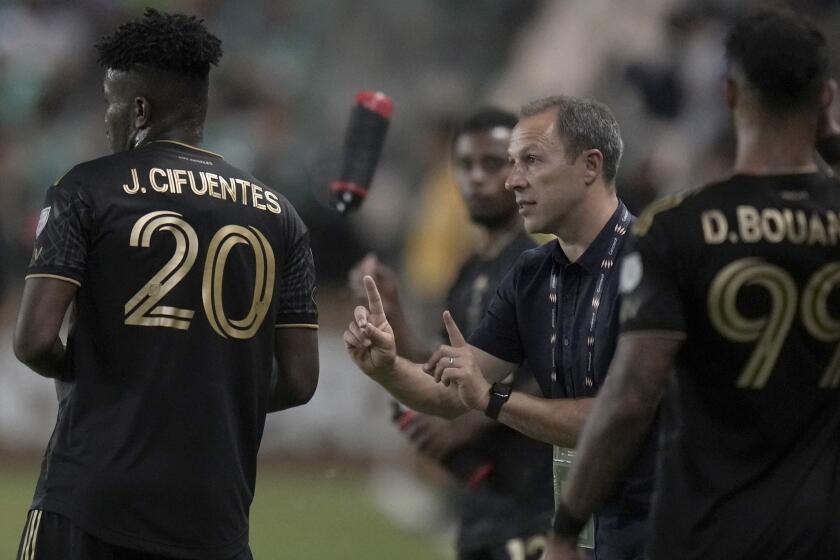Gridlock has Dodger Stadium in a headlock
- Share via
It’s a night of wondrous Dodger Stadium sights, with Fernando Valenzuela on a bobblehead, Don Newcombe taking a bow, and fans booing the San Francisco Giants.
But I’m blinded by another Dodgers tradition.
Headlights. They are glowing from beyond the right-field pavilion, in a long line of cars entering the stadium, in clear sight from my press-box chair. They are no different from the headlights that snake into any major league stadium on any summer night, with one blue twist.
It is the top of the fourth inning. Yes, it is the top of the fourth inning and there is still a line of cars trying to park, folks attempting to go to a baseball game that will be halfway finished by the time find their seats.
That’s crazy. That’s unacceptable. That’s been happening forever here, and it’s still wrong.
You can blame Tuesday night’s jam on fans who were foolish enough to leave late for a legend’s bobblehead night that was a certain sellout, but how does that explain the mess once they arrived in the parking lot? Are Dodgers entrances and parking so bad that even if you blow off three innings, you are still stuck in traffic?
The lights finally disappeared in the bottom of the fourth inning. By the time those fans saw the scoreboard, the game had essentially already been decided, the Giants leading 4-0 en route to a 4-1 victory. Those fans were so late, in fact, their headlights had already been replaced by some taillights from people leaving.
Once again, the worst sporting experience in this town is driving into — and out of — a Dodgers game that fills a 56,000-seat stadium that is baseball’s biggest and most unmanageable. Tuesday was the Dodgers’ 10th sellout this season, which is 10 traffic nightmares too many.
Even when you put on your big-game face, you get burned.
Just ask Michael Roberts, a Dodgers fan from Orange who knew Tuesday’s game would be a sellout and arrived at the Dodger Stadium freeway offramp more than an hour before the first pitch.
“And traffic was at a complete standstill,” he said.
“For a half-hour, we didn’t move.”
Roberts sat outside the stadium for 1 hour 15 minutes — he counted — before finding his seat. It took him longer to travel from the 110 Freeway into Chavez Ravine than it did from Orange to downtown.
“If it’s going to take you two hours to get in and out of the stadium, sure, it might just be easier to stay home,” said Roberts.
The Dodgers have won a surprising number of games while spending a stunning amount of money this summer, but none of that will fix their still-smarting public perception if they don’t fix the gridlock, and they know it.
“We deeply regret any inconvenience that fans may have experienced, and we are working closely with the Los Angeles Department of Transportation, the MTA and the LAPD to try to mitigate the traffic ingress to stadium, and egress as well,” said a Dodgers spokesman Tuesday night. “It’s a difficult situation because of where the stadium is located, when you have large crowds and that many cars. We’re working on it diligently and hopefully we can come up with a solution.”
It’s easy to blame the parking on the Dodgers’ owners, but we’ve been doing that for years and the parking still stinks. Don’t you think if there was a way to fix the unruly lots, they would have been fixed by now?
It’s also easy to blame the parking on the lack of roads leading into and out of Chavez Ravine, but now you’re talking about messing with the surrounding neighborhoods, and that’s already happened once up here.
There’s really only one answer, and it works not only for parking, but on a variety of levels.
The Dodgers need to shrink the stadium. Fewer fans, fewer cars. Shrink it by replacing a bunch of seats with patios and railings and the kinds of restaurants that are landmarks in other stadiums. Transform the mammoth into a more intimate creature that has been so popular in other cities.
Shrink it to also increase comfort, ambience and buzz.
Stan Kasten, the Dodgers president who recently visited the Miami Marlins’ new stadium as part of his research in remodeling his own park, agreed earlier Tuesday night that the building could stand to get smaller.
He didn’t mention parking as the reason, but that could end up being its best byproduct.
“We don’t think the stadium is too small,” he said. “We could lose seats and that would be fine. We haven’t talked about chopping off a deck, but move some rows out to put something else in there.”
He’s talking about perhaps blowing out some upper field-level seats and replacing them with an expanded concourse with railings. He’s talking about maybe trying the same thing in the outfield pavilion.
“I like all the things that new stadiums have ... really wide concourses, a variety of concessions, the entertainment things that can appeal to fans when they get up and do their third-inning cruise,” Kasten said.
“The brilliance of Dodger Stadium is sightlines and spectacular backdrops, but modern fans expect more things.”
Like the ability to go from the stadium entrance to their seat in less time than it once took to play an entire game.
bill.plaschke@latimes.com
twitter.com/billplaschke
More to Read
Go beyond the scoreboard
Get the latest on L.A.'s teams in the daily Sports Report newsletter.
You may occasionally receive promotional content from the Los Angeles Times.











